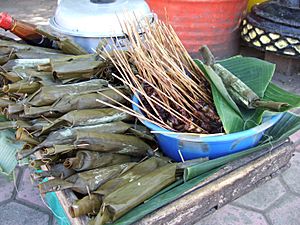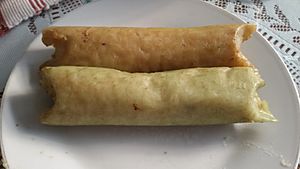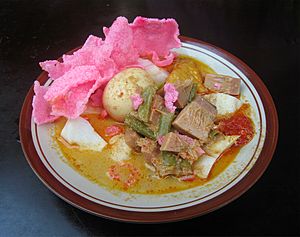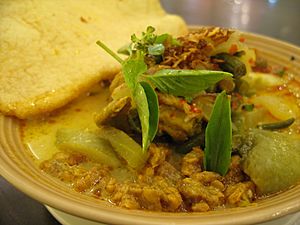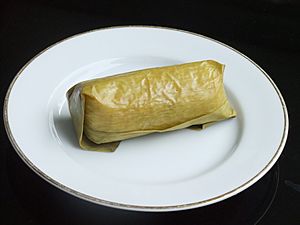Lontong facts for kids
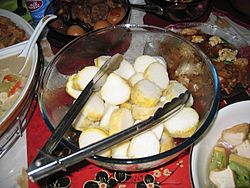
A traditional way of serving lontong
|
|
| Course | Main course |
|---|---|
| Place of origin | Indonesia |
| Region or state | Java |
| Associated national cuisine | Indonesia, Malaysia and Singapore |
| Serving temperature | Room temperature |
| Main ingredients | Compressed rice cooked in banana leaf |
| Variations | Various |
| Similar dishes | Burasa, ketupat, lemang, lepet |
Lontong is a yummy Indonesian dish. It's a special kind of rice cake shaped like a cylinder. This rice cake is wrapped in a banana leaf and cooked. You can find lontong in Indonesia, Malaysia, and Singapore.
People roll rice inside the banana leaf and boil it. After cooking, they cut it into small pieces. Lontong is often eaten instead of regular steamed rice. It feels similar to ketupat. However, ketupat is wrapped in woven young coconut leaves, while lontong uses banana leaves.
In Malaysia, lontong is often called nasi himpit. This means "pressed rice."
Arem-arem is a smaller version of lontong. It is filled with vegetables and sometimes meat. People usually eat arem-arem as a snack.
Lontong is often served warm or at room temperature. It goes well with dishes that have peanut sauce. Examples include gado-gado, karedok, and ketoprak. It's also great with satay. You can also eat lontong with soups made from coconut milk. These include lontong sayur, soto, and gulai. Sometimes, it's used instead of noodles.
Contents
The Story of Lontong
Lontong has a history connected to ketupat. Both dishes use steamed rice wrapped in leaves. At first, lontong was just a simple food. But when Islam spread to Java, eating lontong and ketupat became a tradition.
A wise person named Sunan Kalijaga first shared lontong with the Javanese people. This was part of his teachings at that time. Lontong is often served with Gulai sauce and vegetables. These vegetables can include chayote, tempeh, and tofu. Other tasty additions are tauco, boiled egg, sambal, and crackers.
How Lontong is Made
Traditionally, lontong is made by boiling rice until it's partly cooked. Then, this rice is packed tightly into a rolled-up banana leaf. The leaf is held shut with a small wooden stick. This stick is called lidi semat. It's made from the middle part of a coconut leaf. The rice package is then cooked in boiling water for about 90 minutes.
Once the rice cools down, it becomes firm. Then, it can be cut into small, bite-sized pieces. The outside of lontong often looks a bit green. This is because some of the green color from the banana leaf rubs onto the rice.
There are other ways to make lontong too. One way is to put uncooked rice into a muslin bag. The water then seeps in, making the rice stick together. A popular and easier method uses plastic pouches. These pouches are filled with rice and poked with small holes. This lets water get inside when they are boiled. The rice cooks and fills the pouch. This method tries to copy how banana leaves work. However, using real banana leaves is better for your health and the environment.
In Malaysia, nasi himpit is made differently. Freshly cooked rice is pressed for several hours. Heavy stones or trays are used to press it. This makes the rice very firm. But now, nasi himpit is also often made quickly. People use water-friendly plastic bags filled with rice and boil them.
Dishes with Lontong
Lontong itself has a mild, plain taste, just like plain rice. Its flavor comes from the other ingredients, spices, and sauces it's served with. Lontong is a good substitute for steamed rice. It can be eaten with almost any traditional dish. But it's most often served with peanut sauce or coconut milk-based soups.
Lontong Dishes in Indonesia
Lontong Sayur
In Indonesia, especially among the Betawi people, lontong is often served as lontong sayur. This dish has pieces of lontong in a creamy coconut milk soup. The soup includes shredded chayote, tempeh, tofu, and a hard-boiled egg. It's also served with sambal (chili sauce) and kerupuk (crackers). Lontong sayur is similar to Ketupat sayur. It's a popular breakfast choice, like bubur ayam (chicken porridge) and nasi uduk (coconut rice).
Lontong Cap Go Meh
Lontong cap go meh is a more fancy lontong dish. It's a Peranakan Chinese Indonesian version of traditional Indonesian foods. Lontong is served with rich opor ayam (chicken in coconut milk), sayur lodeh (vegetable stew), and sambal goreng ati (spicy beef liver). It also comes with acar (pickles), telur pindang (hard-boiled tea egg), abon (beef floss), and koya powder (a mix of soy and dried shrimp powder). Chinese Indonesian communities usually eat Lontong cap go meh during the Cap go meh celebration.
Lontong Dekem
Lontong dekem comes from Pemalang Regency in Central Java. The name dekem means "immersion" in the local Javanese language. This is because the lontong is soaked in soup until it's fully covered.
Lontong Kari
Lontong kari is lontong served in a soupy chicken curry with vegetables. Curry was first brought to Indonesia by Buddhist monks from India.
Lontong Kikil
Lontong kikil is lontong served in a spicy soup made from cow's trotters (cow's feet) and vegetables.
Lontong Kupang
Other lontong dishes include lontong kupang. This dish is from the Surabaya and Sidoarjo areas in East Java. Lontong kupang is made with lontong and small white clams.
Lontong Balap
Also from Surabaya, lontong balap is a mix of lontong, taoge (bean sprouts), fried tofu, and lentho (fried mashed beans). It's topped with fried shallots, sambal petis, and sweet soy sauce. East Javanese lontong and tofu dishes are famous for their unique taste. This comes from using a lot of petis, which is a type of shrimp paste.
Lontong Gulai Pakis
In West Sumatra, there's a Minang dish called lontong gulai pakis. This dish has lontong served with young fern leaves in a gulai sauce. It's usually served with hard-boiled eggs and kerupuk jangek or krupuk kulit (cow skin crackers).
Arem-arem
Arem-arem is a smaller lontong that's filled with yummy things. It often has diced vegetables like carrot, common bean, and potato. These are seasoned with salt and chili. Sometimes, it's filled with tofu, oncom, or tempeh. You might also find it with minced meat or abon (beef floss). People eat arem-arem as a snack. The rice in arem-arem is flavored with coconut milk.
In Javanese, this snack is called arem-arem. But in other parts of Indonesia, it's simply called lontong or lontong isi (filled lontong). It's a common snack in Java. It's quite similar to lemper, but lemper uses sticky rice, while arem-arem uses regular rice. Arem-arem usually has a thin, young banana leaf wrapper. This leaf is light yellow-green. Regular lontong, on the other hand, uses a thicker, more mature banana leaf. The texture of arem-arem is softer than regular lontong. This is because of the thinner banana leaf, the added coconut milk, and longer cooking time.
Lontong in Malaysia and Singapore
In Malaysia, lontong is commonly called nasi himpit. This means "pressed rice." Unlike traditional lontong, nasi himpit is often made by pressing rice overnight. The lontong rice cake is cut into smaller pieces. These pieces are known as nasi himpit.
In Malaysia and Singapore, the term lontong usually refers to a dish. This dish has rice cakes in a coconut-based soup, like sayur lodeh. This soup contains shrimp and vegetables such as chopped cabbage, turnip, and carrots. Extra toppings are added either during cooking or when serving. These can include fried tempeh, fried tofu, boiled eggs, spicy dried cuttlefish sambal, fried spicy shredded coconut (serunding kelapa), or fried chicken.
Nasi himpit is also eaten with satay and peanut sauce. In the eastern states of Peninsular Malaysia, nasi himpit is a breakfast food with kuah kacang (peanut sauce). It's also an ingredient in the Malaysian version of chicken soto.
Images for kids
See also
 In Spanish: Lontong para niños
In Spanish: Lontong para niños


